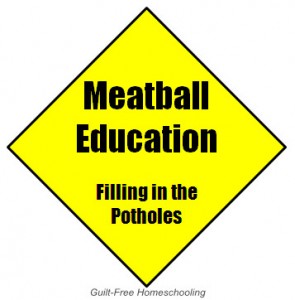It worked for Jesus, and it has worked for me. Whether you are folding laundry, making bread, or shingling a roof, this method works:
You do it with them watching you.
You do it with them helping you.
They do it with you helping them.
They do it with you watching them.
You leave with them doing it alone.
Jesus modeled this method for His disciples by teaching and healing the multitudes. As the disciples watched Jesus, they learned. As Jesus had Peter, James, and John step aside with Him to heal, they learned. Jesus had the disciples try it on their own, while He stayed nearby to assist when needed. Finally, He was able to send them out with confidence.
Now we can apply this same method to teaching many new tasks, from long division to changing a tire. First, you let your students watch to get a good idea of how the job is supposed to go when it is done correctly. For many jobs, your children have already watched you do it over and over, informally — they did not realize they were learning something, they thought they were just watching Mom do her jobs.
Second, allow the students to help with the easier portions of the job and work their way up to trying the more complicated parts. Again, you may have already accomplished this stage, simply taking advantage of the extra pairs of hands.
Third, trade places with your students and take over the role of helper, doing the easy tasks for them, but remaining close by in case the students need assistance with the trickier operations. This can be a scary step — actually turning over the outcome of the task to someone else. But if we think about what really matters, teaching the skill itself is much more important than having the towels folded perfectly straight.
Fourth, step back a little and observe your new trainees as they perform the entire task by themselves. It is often a good idea at this stage to “act busy,” involving yourself in another nearby task so that your apprentices do not get nervous from being watched. Keep watching until they are confident in their newfound ability, then walk away to your next job — or maybe free time!
Remember, practice makes perfect: your new worker will probably not do the job exactly the same way you do it, but they will get better with time, and it is important also to emphasize that to the child. “I don’t expect you to do it the same way Mommy does it because you just started, and I’ve got 20 years of practice ahead of you. But I know you will get better and faster the more you do it.” Then be sure to praise their progress!





 Guilt-Free Homeschooling is the creation of Carolyn Morrison and her daughter, Jennifer Leonhard. After serious disappointments with public school, Carolyn spent the next 11 years homeschooling her two children, from elementary to high school graduation and college admission. Refusing to force new homeschooling families to re-invent the wheel, Carolyn and Jennifer now share their encouragement, support, tips, and tricks, filling their blog with "all the answers we were looking for as a new-to-homeschooling family" and making this website a valuable resource for parents, not just a daily journal. Guilt-Free Homeschooling -- Equipping Parents for Homeschooling Success!
Guilt-Free Homeschooling is the creation of Carolyn Morrison and her daughter, Jennifer Leonhard. After serious disappointments with public school, Carolyn spent the next 11 years homeschooling her two children, from elementary to high school graduation and college admission. Refusing to force new homeschooling families to re-invent the wheel, Carolyn and Jennifer now share their encouragement, support, tips, and tricks, filling their blog with "all the answers we were looking for as a new-to-homeschooling family" and making this website a valuable resource for parents, not just a daily journal. Guilt-Free Homeschooling -- Equipping Parents for Homeschooling Success!

Recent Comments